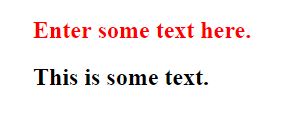CSS pseudo-classes
The CSS pseudo-classes (starts with a colon (:)) allow you to style the dynamic states of an element such as hover, active, and focus state.
syntax :
selector:pseudo-class { property: value; }
Anchor Pseudo-classes:
<!DOCTYPE html>
<html>
<head>
<style>
/* unvisited link */
a:link {
color: red;
}
/* visited link */
a:visited {
color: green;
}
/* mouse over link */
a:hover {
color: hotpink;
}
/* selected link */
a:active {
color: blue;
}
</style>
</head>
<body>
<h2>CSS Links</h2>
<p><b><a href="https://www.i2tutorials.com/">This is a link</a></b></p>
</body>
</html>
OUTPUT:

The :first-child Pseudo-class:
This class matches a specified element that is the first child element of another element.
<!DOCTYPE html>
<html>
<head>
<style>
h2:first-child {
color: red;
}
</style>
</head>
<body>
<h2>Enter some text here.</h2>
<h2>This is some text.</h2>
</body>
</html>
OUTPUT:

The :lang Pseudo-class:
This class allows construction selectors based on the different language settings for specific tags.
Example:
<!DOCTYPE html>
<html>
<head>
<style>
q:lang(no) {
quotes: "~" "~";
}
</style>
</head>
<body>
<p>Some text <q lang="no">A quote in a paragraph</q> Some text.</p>
</body>
</html>
OUTPUT:

